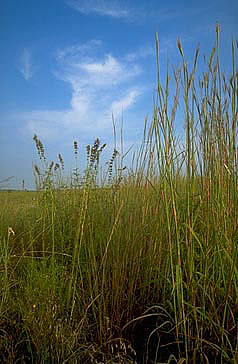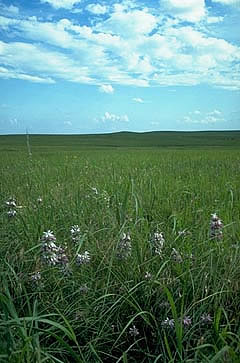This project is designed to support the basic and applied research needs of projects conducted by the industry consortium PERF relating to ERAs at upstream sites.
The petroleum and natural gas industry is concerned that the industry will come under increased regulatory scrutiny concerning ecological impacts at upland E&P sites (wellheads, tank batteries, metering stations, gas plants, etc.). Conducting ERAs at each of the thousands of E&P sites would place a huge financial burden on the industry, which could impact their competitiveness and ultimately would be felt by consumers. However, protecting natural ecological resources is also clearly in the best interest of the country. Developing methodologies and techniques to screen out truly ecologically innocuous sites-while identifying those sites where ecological impact is significant-is an important effort. This project has direct application to PERF-99-01 (Ecological Evaluations of Upstream Sites) and potential application to PERF-99-13 (Expanding the Science Basis for Risk).
Project Results
LLNL participated in a multi-disciplinary team consisting of industry, government, National Laboratories, and private consulting firms to develop ecological assessment techniques for upstream E&P sites that are protective of ecological receptors at the population, community, or ecosystem level.
Work described here is designed to compliment research being conducted under FEW0067/FEAC321 by LLNL and ORNL through NGOTP. That research was specifically designed to investigate the role of size and spatial distribution of small impacted or contaminated sites to the larger ecosystem or landscape.
The work performed includes: 1) participation in all scoping and project meetings with industrial and National Laboratory partners as necessary; 2) general PERF support to industrial partners, including preparation and presentation of symposia papers and discussion papers on potential new research topics; 3) participation in E&P site visits, site selection, and ecological endpoint selection; 4) development of techniques to construct general conceptual ecological models of E&P sites; 5) review of the relevant conservation biology literature; 6) review of existing E&P site data; 7) collection of additional site data as required; 8) general project management and review of the geographical information systems (GIS) design, database design, modeling design, and modeling results; and 9) overall project reporting.
Benefits
The interactive website developed as part of the project provides data on the range of population, plus a list of vegetation types present, sorted by area. The ability to identify and eliminate permit requirements sites that do not have significant environmental problems would greatly improve the process of permitting and reduce the costs. High-speed data processing of field data provides cost-effective project management.
Project Summary
LLNL actively contributed to the finalization of objectives for PERF-99-01:
- Developing ecological approaches to determine ecological risk at upstream sites.
- Developing exclusion criteria for spill release sites based on size of spill site.
- Validating the current guidelines for total petroleum hydrocarbons (TPHs) in soil as protective of ecological receptors.
The Tall Grass Prairie Preserve (TGPP) in Oklahoma was selected for a study site for the development of ecological assessment protocols. At the request of DOE through industry partners (American Petroleum Institute, Chevron, and ExxonMobil), LLNL developed a unique research plan to evaluate the current TPH-in-soil guidelines. This research focused on evaluating the ecological recovery from TPH releases by collecting specific vegetation and small-mammal data from multiple historic spill sites.
Development was completed of a protocol for developing conceptual trophic models at large E&P sites, using the TGPP as an example site. This protocol will be extremely useful to E&P site managers by allowing them to efficiently and cost-effectively organize data on the species known or thought to occur at their site in a manner that will be useful for future ERAs. LNLL completed a review of the fragmentation, home range, and critical patch size literature to determine what this literature may reveal with respect to developing an exclusion criteria based on size. A working summary data table and a working model summary document were developed from this review. From the LNLL review, it was concluded that size criteria will be constrained by the general context of the facility and by the general type of endpoint species present.
LNLL participated in the collection of additional onsite GPS data at the TGPP of well location, well pad area, and brine and oil spill locations and size. Researchers reviewed the preliminary site statistics and the spatial modeling plan developed under FEW0067/FEAC321. A draft manuscript has been completed of the review of the conservation biology literature with respect to the development of spill-size exclusion criteria. Removal of habitat area as a consequence of a release of petroleum products to the environment can be considered a form of habitat fragmentation. However, as pointed out in the conservation biology literature, habitat fragmentation typically results in small areas of intact habitat within a hostile matrix of unsuitable area. However, small, isolated spills at large E&P sites result in small areas of unsuitable habitat within a matrix of intact habitat. A summary of knowledge was completed that determined what was known about home range and critical patch size requirements and compared these spatial needs to example spill sizes at the TGPP. In addition, the available population models for evaluating spatial need in more detail were explored. It was concluded that home range and critical patch size can be used as a gross, first-cut indicator of potential ecological impact as a consequence of habitat loss due to spills, but these conclusions should at least initially be substantiated using simulation modeling. LLNL has begun rebuilding the website using Active Server Pages (ASP) and ArcIMS, which will add features needed for development of a population model interface. By using ASP, the website now can interact directly with other ActiveX(COM) applications at the server end. This opens up high-speed queries into relational database management systems (RDBMS) on the server. The data-based website will be used to run the population models being developed by LLNL and ORNL under FEW0067/FEAC321. Development of an ActiveX.dll will allow complex GIS functionality to be initiated directly from the website. The data can provide the range of population, plus a list of vegetation types present, sorted by area.





